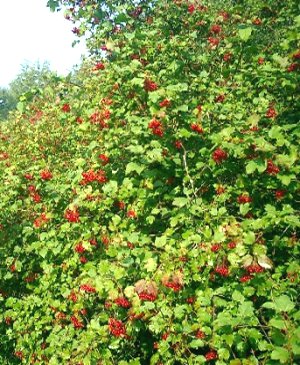
|
 October 8, 2008 October 8, 2008  That Other Cranberry
It's a native, also. It goes by the name American Cranberrybush, American Highbush Cranberry, cherry wood, red elder, rose elder, squaw bush, witch-hobble, crampbark tree and several other nicknames from its rich, native-American past. Its bark yields a powerful anti-spasmodic, a characteristic of a close relative, the black haw.
The common name of Viburnum trilobum alludes to the resemblance of its fruit to the commercial American cranberry (Vaccinium macrocarpon), also a native.
|
The highbush cranberry is a valuable plant for a variety of reasons. It is a wonderful ornamental landscape plant. Its fruit is edible, bright red and jewel-like. When properly prepared, its fruit is used to make sauces, jellies, jams, juice and, of course, wine. Its fall foliage is very beautiful and colorful, changing from dark green to yellow to red-purple. Its new growth in spring is tinged with red. The fruit of the highbush cranberry persists on the plant throughout the winter, often maintaining its color after several freezes.
Here is a plant that is easy to grow, is not fussy about soils, and has few pests or problems. The one in my backyard (see photo) is approximately twelve feet wide by twelve feet high. It grows in an open habit with a round top and is fairly dense. Its spring show is wonderful if more subtle, with white flat topped clusters of flowers of two types, with those in the outer ring being sterile and showy, and those in the inner ring much smaller, fertile and with yellow anthers.
|

This Highbush cranberry in my back yard is loaded
with jewel like fruit that will persist well into winter.
|
The highbush cranberry has many virtues. It is an excellent plant choice for screening and informal hedging, often referred to as a living fence. It is very durable, hardy to Zone 2, requires almost no care, prefers partial shade to some sun and will do best in soil that is consistently moist and well drained.
Highbush cranberries are environmentally very friendly. They serve as riparian filterstrips that can mitigate flooding and soil erosion, trap nutrients, and provide valuable shelter for wildlife. In larger landscapes they also serve as handsome and very functional living snow fences.
Chipmunks, squirrels, skunks, mice, rabbits, grouse, pheasants, robins, cedar waxwings, and other songbirds often enjoy the fruit. Most birds prefer to wait until after the fruit has been exposed to several freeze/thaw events.
The ideal care might be an annual application of compost or well-aged manure. I've done nothing and each year it outperforms the previous. I've only done minimal pruning, and then only to provide an archway/entrance to a small garden room I created. The best time to prune is immediately after flowering.
It's easiest to propagate highbush cranberries from softwood cutting in June through late July. They will usually root in six weeks with a rooting hormone dip, a peat/perlite rooting medium and mist. Layering and crown division are two other methods you might use to propagate them. Seed propagation requires the usual warm/cold treatment and might be more tedious than not.
It may interest you to know that some very beautiful and showy "snowball bushes" are viburnums, not hydrangeas. See Viburnum opulus 'Roseum', for example. There are also a variety of other handsome viburnums that you might investigate if this plant profile stimulates you to explore further.
And, if you like the attributes of our native Viburnum trilobum, there are several cultivars for differing tastes that might be explored. There are different growth habits, fruit coloration, foliage changes, compact and even dwarf forms. Our native plant has given reason to much celebrate, use, and preserve. If you have the time and the room, why not try one or more.
Autumn is a second spring when every leaf is a flower. - Albert Camus
From
The Garden of Ed. Submitted for publication in The Towne Crier on
October 8, 2008
© 2008 Ed Mues. All Rights Reserved.

eMail:
eGarden@MountainAir.us

|

|

